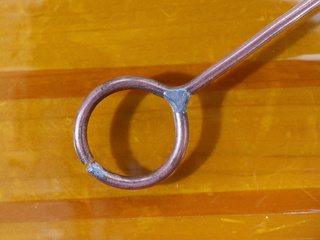Oct. 27, 2015
Takayuki HOSODA

Internal diameter φ ≈ 14 mm, gap ≈ 300 μm


Magnetic field probes are often used in EMC compliance-related experiments. If it is not important that the probe be calibrated, we often make our own magnetic field probes to suit the application. Magnetic field probes are relatively easy to make with semi-rigid cables. Here is my method of making a magnetic field probe of a size suitable for the UHF band, which is often used for EMC experiments.
Prepare SC-219/50 semi-rigid cable and cut out the outer conductor and insulator to create a gap of 700 ~ 1000 μm.
Gaps that are too narrow can cause resonance at relatively low frequencies, while gaps that are too wide pick up unwanted electric fields.
Form the inner conductor of the SC-219 semi-rigid cable to create a C-shaped part for the short ring.
Fit and caulk the short ring as described above.
Wrap a heat-resistant thread such as Kevlar around one side of the short ring and press the short ring against the outer conductor.
The gap between the short ring and the outer and inner conductors is filled with solder to provide a high-frequency short circuit.
Semi-rigid cables are bent and shaped into loops with an internal diameter of about 14 mm, and the outer conductors at the cable end are connected to each other by soldering.
Cut the other end of the semi-rigid cable to an appropriate length and solder the center conductor of the SMA connector.
Solder the outer shell of the SMA connector.
Measure S11 to verify that the self-resonant frequency is above 3 GHz.
http://www.finetune.co.jp/~lyuka/technote/mprobe/


![[Mail]](/~lyuka/images/mail.gif)



 © 2000 Takayuki HOSODA.
© 2000 Takayuki HOSODA.